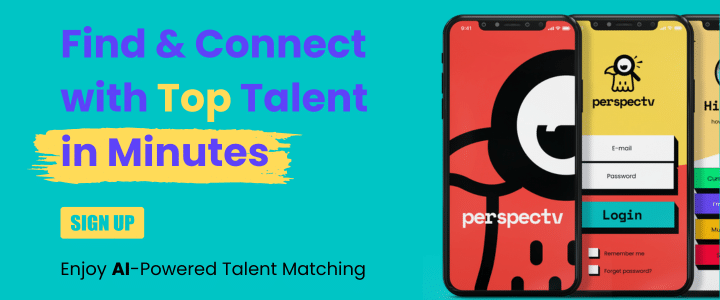Understanding The Shortcomings of Traditional Recruiting Methods
We explore 5 Reasons Why Traditional Recruiting Methods are Failing.
In the current dynamic job market, it’s becoming clear that traditional recruiting methods are no longer effective.
They struggle to keep up with the pace, diversity and complexity of today’s hiring needs. This article dives into why these methods are losing their effectiveness, and how modern recruitment strategies offer a solution.
What to expect:
- 5 Reasons why traditional recruitment methods are failing.
- The problem with traditional methods like online job boards and recruitment agencies.
- A look at modern recruitment methods – could AI Talent Matching be the solution to better hiring decisions.
- Finally, we take a look at why nearly half of all new employees quit.
5 Reasons Why Traditional Recruiting Methods are Failing
1. Unconscious Bias:
- Issue: Traditional recruitment methods can inadvertently perpetuate unconscious bias. Recruiters and hiring managers may unintentionally favor candidates who resemble them in terms of demographics, backgrounds, or experiences, leading to unfair and potentially discriminatory hiring practices.
- Impact: This bias can result in a lack of diversity within the workforce, limiting the potential for fresh perspectives, innovative ideas, and varied skill sets.
- Solution: Modern recruitment strategies incorporate diversity and inclusion initiatives, blind recruitment processes, and structured interviews to mitigate unconscious bias and promote fairness in hiring decisions.
2. Time-Consuming:
- Issue: Traditional methods, such as manually sifting through stacks of resumes or conducting extensive rounds of interviews, are notoriously slow and inefficient.
- Impact: Lengthy hiring processes can frustrate both candidates and employers, causing top talent to lose interest and seek opportunities elsewhere.
- Solution: Automation, applicant tracking systems (ATS), and streamlined hiring workflows can significantly reduce the time and effort required to identify and onboard qualified candidates.
3. High Costs:
- Issue: Traditional recruiting often involves expenses such as recruitment agencies’ fees, advertising costs, and overhead associated with in-house HR teams.
- Impact: These high costs can strain a company’s budget, especially for smaller businesses, and limit the resources available for other crucial aspects of the business.
- Solution: Companies are turning to cost-effective alternatives, such as social media recruiting, employee referrals, and building a strong employer brand, to reduce recruitment expenses.
4. Inaccurate Matching:
- Issue: Traditional recruitment heavily relies on resumes and interviews, which may not provide a comprehensive view of a candidate’s skills, personality traits, and potential cultural fit.
- Impact: Hiring decisions based solely on CVs can result in misalignment between candidates and job roles, leading to high turnover rates and decreased job satisfaction.
- Solution: Behavioral assessments, skills tests, and competency-based interviews help recruiters gain a more accurate understanding of a candidate’s suitability for a role, enhancing the matching process.
5. Lack of Engagement:
- Issue: Traditional recruitment methods often fail to effectively engage candidates, particularly passive job seekers or those with specialised skills.
- Impact: Top-tier talent, including passive candidates, may not respond well to one-size-fits-all job postings or standard application processes, potentially causing companies to miss out on valuable hires.
- Solution: Engaging and nurturing candidates through personalised communications, showcasing company culture, and leveraging professional networks can attract and retain high-caliber talent, including those not actively seeking new opportunities.
In conclusion, the limitations of traditional recruitment methods are increasingly evident in today’s dynamic job market.
To address these challenges, organisations are adopting modern, technology-driven approaches that prioritise fairness, efficiency, cost-effectiveness, accuracy and candidate engagement.
By embracing these innovations, companies can enhance their ability to attract, select, and retain the best talent, ultimately contributing to their long-term success and growth.
The Problem: The Flaws of Traditional Recruitment Methods

Let’s delve into the challenges posed by traditional recruitment methods, including online job boards, recruitment agencies, and an overreliance on CVs:
Online Job Boards:
Challenge 1: Overwhelming Number of Applications
- Issue: Online job boards offer a vast and accessible platform for posting job vacancies, attracting a broad array of candidates. However, this quantity often translates into an overwhelming volume of applications.
- Impact: The sheer volume of applications can pose a significant challenge for hiring teams. Sorting through numerous resumes consumes valuable time and resources, diverting them from other critical tasks like interviewing and candidate engagement.
- Solution: To mitigate this challenge, many organisations turn to applicant tracking systems (ATS) that use automation and filtering mechanisms to categorise and prioritise applications based on predefined criteria. This helps streamline the initial screening process and focus on the most relevant candidates.
Challenge 2: Risk of Overlooking Suitable Candidates
- Issue: The process of sifting through a large number of applications on job boards may lead to recruitment fatigue, with hiring professionals becoming overwhelmed and potentially missing out on qualified candidates.
- Impact: Overlooking suitable candidates can result in a less diverse pool of talent, missing out on potentially exceptional hires, and ultimately delaying the hiring process.
- Solution: Implementing well-defined job descriptions and requirements can help narrow the applicant pool. Additionally, conducting preliminary screening assessments or leveraging technology to analyse resumes for specific keywords can identify top candidates more efficiently.
Recruitment Agencies:
Challenge 1: High Costs
- Issue: Recruitment agencies often charge substantial fees, typically a percentage of the candidate’s first annual salary. These fees can be a significant financial burden for organisations.
- Impact: High recruitment agency fees can strain a company’s budget, especially for small and medium-sized enterprises (SMEs). This cost may limit the resources available for other crucial aspects of the business.
- Solution: To reduce costs, some companies choose to establish their in-house recruitment teams, focusing on employer branding, building talent pipelines, and leveraging cost-effective sourcing strategies such as employee referrals and online networking platforms.
Challenge 2: Speed vs. Quality
- Issue: Recruitment agencies are often motivated to fill positions quickly to secure their fees. This can sometimes lead to a focus on speed over quality in candidate selection.
- Impact: Prioritising speed over suitability can result in costly turnover as candidates who are not the best fit for the role may be selected hastily.
- Solution: Collaboration between organisations and recruitment agencies should prioritize finding the right candidate over expedient placements. Clear communication about the company’s culture, values, and specific job requirements is essential to ensure a better match.
Overreliance on CVs:
Challenge 1: Limited Assessment of Skills and Potential
- Issue: Relying heavily on CVs as the primary source of information can limit the evaluation of a candidate’s skills, experience, and potential.
- Impact: This limitation can lead to misalignment between candidates and job roles, resulting in high turnover rates and decreased job satisfaction.
- Solution: Complementing CV analysis with skills assessments, behavioral interviews, and competency-based evaluations can provide a more holistic view of a candidate’s capabilities. These additional evaluation methods help identify the best fit for the role based on both hard and soft skills.
Challenge 2: Unconscious Bias
- Issue: Decisions based primarily on CVs can inadvertently perpetuate unconscious bias. Factors such as the candidate’s name, gender, or age may unintentionally influence hiring decisions.
- Impact: Unconscious bias can lead to a lack of diversity within the workforce, limiting the potential for fresh perspectives, innovative ideas, and varied skill sets.
- Solution: Implementing structured and standardised interview processes, along with diversity and inclusion initiatives, can help mitigate unconscious bias in hiring decisions.
In conclusion, traditional recruitment methods have their inherent challenges, including the management of overwhelming applicant volumes, high costs associated with recruitment agencies, and the potential for bias when overly relying on CVs.
To overcome these challenges and enhance the effectiveness of talent acquisition, organisations are increasingly adopting innovative and data-driven approaches that focus on fairness, efficiency, cost-effectiveness, accuracy, and candidate engagement.
The Solution: Embracing Modern Recruitment Methods

Modern recruitment methods offer a fresh and effective approach:
Social Media Recruiting:
This harnesses the power of platforms where potential candidates spend a significant amount of their time, and can offer a deeper insight into their interests, skills, and personality.
Video Interviewing:
This offers a more personal view of the candidate earlier in the process, providing a more holistic understanding of their communication skills, professionalism, and cultural fit.
Gamified Assessments:
These provide a fun and engaging way to evaluate a candidate’s problem-solving skills, creativity, and potential for growth.
AI-Powered Recruiting Tools:
Perspectv is revolutionising recruitment with its AI Talent Matching app.
More than just a tool for efficiency, Perspectv transforms the recruitment landscape by truly understanding job seekers. By leveraging sophisticated machine learning algorithms, Perspectv delves deeper than basic qualifications and experiences.
It evaluates personality traits, capturing essential insights into how potential candidates think, act, communicate, and behave.
This comprehensive approach ensures an accurate and nuanced matching of candidates to job roles, leading to more successful and harmonious workplaces.
But Perspectv’s innovative approach doesn’t stop there. The platform is challenging the traditional recruitment fee model too.
With a groundbreaking Pay Per Match fee model, employers pay a fixed rate of £35 per profile, only paying for the candidates they are genuinely interested in meeting.
By doing this, Perspectv is not only enhancing the way employers discover talent but also making the entire recruitment process more cost-effective and transparent.
The Evidence that Traditional Recruitment Methods are Falling Short
Several studies highlight the shortcomings of traditional recruitment methods.
For instance, CareerBuilder found that 74% of organisations admitted to hiring the wrong person for a role.
Additionally, a study by Vervoe found that 66% of employees have accepted jobs that weren’t the right fit, with half of them leaving within six months.
Why do 45% of New Employees Quit Within the First 3 Months
The reasons behind a new employee leaving a company within the first three months can be multifaceted and often hinge on issues like poor onboarding processes, unclear role expectations, a lack of company culture fit, or miscommunication during the hiring process.
Poor Onboarding:
If a company does not have an effective onboarding process in place, new employees may feel lost and unsupported, leading to early resignation. A robust onboarding plan helps newcomers understand their role, align with the company culture, and integrate into the team more smoothly.
Unclear Job Expectations:
If a job role wasn’t accurately depicted during the recruitment process, a new employee may feel deceived or overwhelmed once they start. It’s crucial for employers to provide clear and realistic job descriptions and expectations from the onset.
Misaligned Company Culture:
If an employee doesn’t feel aligned with the company’s values and culture, they may not feel like they belong. A sense of belonging is essential for an employee’s job satisfaction and long-term commitment to the organisation.
Inadequate Compensation or Benefits:
If an employee feels that their compensation or benefits package is inadequate or not as promised, it can lead to dissatisfaction and early resignation.
Lack of Career Growth Opportunities:
If employees see no path for advancement or professional development, they might decide the job isn’t a good long-term fit and opt to leave early.
Poor Management:
Poor management practices, including lack of communication, respect, or support, can significantly impact job satisfaction and employee retention.
Again, using modern recruitment tools like Perspectv can help reduce early employee turnover by ensuring a better match between the candidate’s skills, personality traits and the job role, leading to more successful hires and longer-lasting employment relationships.



